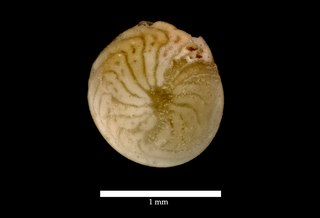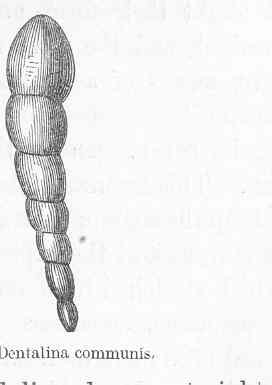Related Research Articles
Carterina is a genus in the family Trochamminidae, composing its own subfamily Carterininae. The genus is described from specimens gathered during the Challenger expedition's circumnavigation of the Earth from 1872-1876.

The Asterigerinacea is a superfamily of Foraminifera included in the order Rotaliida, proposed by Loeblich and Tappan in 1988.
The Spirillinida are an order of foraminifera in which the test, or shell, primitively consists of an enrolled open tube, coming after the proloculus, wound planospirally or conically, commonly composed of an optically single crystal of calcite. The aperture is a simple opening at the end of the tube. Advanced forms with more than one chamber may consist of a few crystals, or rarely, a mosaic of crystals of calcite.
The Fusulinidae is a family of fusulinacean foraminifera from the upper Carboniferous to the Upper Permian (Guadalupian), tests of which are fusiform to subcylindrical with walls of two to four layers. Are planispirally coiled throughout or with early whorls at a distinct angle to the later plane of coiling. Septa, flat to well fluted; tunnel, single; chomata variable in development.
Verbeekinidae are a family of large fusulinaceans characterized by subspherical, planispirally coiled tests and a long coiling axis. The wall is composed of a dense outer tectum and inner alveolar keriotheca. They are most prominent in Japan and Southeast Asia.

Lagenida is an order of benthic foraminiferal rhizaria in which the tests (shells) are monolamellar, with walls composed of optically and ultra-structurally radiate calcite, with the crystallographic c-axes perpendicular to the surface. Lagenids first appear in the Upper Silurian and continue to the Recent. They are currently divided into two superfamilies, the older Robuloidacea which range from the Upper Silurian to the Lower Cretaceous (Albian) and the younger Nodosariacea, ranging from the Permian to Recent.
Nodosariacea is one of two superfamilies making up the foraminiferal order Lagenida. The other being the Robuloidacea. Of these two Nodosariacea is the more advanced, as well as being the younger.

Cibicides is a genus of cosmopolitan benthic foraminifera known from at least as far back as the Paleocene that extends down to the present.
Rosalina is a genus of foraminifera included in the rotaliid family Rosalinidae.
The Nonionidae is a foraminifera family within the order Rotaliida and part of the Nonionacea, shells, or tests, of which are planispiral or trochospiral, calcareous and finely perforate. Includes the Nonioninae, Pulleniinae, Spirotectinae, and Astrononioninae.
The Ammodiscacea is a superfamily of foraminifera in the order Textulariida. tests are made of agglutinated grains and consist of a proloculus followed by an enrolled tubular second chamber open at the distal end, that lacks internal septa but which may have growth constrictions.
Sigmoilinopsis is a genus of miliolid Foraminifera, with an ovate test, chambers one-half coil in length, arranged in rapidly changing planes in the early stage resulting in two spiralling series that appear sigmoid in section, gradually becoming planispiral in the adult. Walls are thick, porcelaneous but enclosing a large quantity of agglutinated quartz particles, sponge spicules, and shell fragments; the aperture terminal, rounded, with a small tooth.

Hauerinidae is a large and diverse family of miliolid forams that includes genera distributed among various subfamilies in the Treatise as well as genera named and described since.

Fischerinidae is a foraminiferal family now in the miliolid superfamily Cornuspiracea that comprises genera that can be free or attached, in which the proloculus is followed by an undivided tubular or spreading second chamber. Commonly, especially in free, i.e. unattached, forms the second chamber is looped around in coils. As diagnostic for the Miliolida the test wall is of imperphorate porcelaneous calcite. The aperture, which is the avenue of egress and ingress for the protoplasm, is terminal; can be rounded or slitlike.
Hemigordiopsidae is a miliolid family included in the Cornuspiracea that has a range extending from the Early Carboniferous (Visean) to the present.
Cornuspiracea comprise a superfamily of miliolid forams in which the test may be free or attached, planispiral or trochospiral, evolute or involute, spreading or discoidal. The proloculus, or initial chamber, is followed by undivided spiral passage or enrolled tubular chamber, later may be irregularly coiled, unicoiled, or show zigzag growth pattern and may be distinctly chambered. The test wall is composed of imperforate porcelaneous calcite, a character of the Miliolida
Globigerinana are free living pelagic foraminiferan, included in the class Rotaliata that range from the Jurassic to recent. Test are commonly planospiral or trochospiral but may be uniserial to multiserial and are of secreted hyaline (glassy) calcite. Chambers are flattened in planospiral forms and spheroidal in trochospiral and serial forms. Some have long radial spines, or needles that may be solidly fixed or moveable in sockets. Gametes are biflagellate and are produced in greater number than by bottom dwelling benthic forms.
The Involutinidae are a family of foraminifera included in the Involutinida, characterized by calcareous tests consisting of an undivided planispirally to trochospirally coiled tubular second chamber wound around the initial proloculus, and which may have thickenings or nodes on one or both sides. This family includes four subfamilies, Aulotortinae, Involutininae, Triadodiscinae, and Triasininae.
The Planispirillinidae are a family of living Foraminifera and the only one of the Involutinida now living.
The Ventrolaminidae are a family of benthic Foraminifera included in the Involutinida, now part of the subclass Spirillinana, class Spirillinata.
References
- 1 2 Alfred R. Loeblich Jr & Helen Tappan,1988. Forminiferal Genera and their Classification. Van Nostrand Reinhold.
- ↑ Loeblich, Alfred R.; Tappan, Helen (1964). Moore, R.C. (ed.). Protista 2: Sarcodina Chiefly "Thecamoebians" and Foraminiferida. Treatise on Invertebrate Paleontology. Vol. C (5th ed.). Geological Society of America. ISBN 978-0-8137-3003-5.